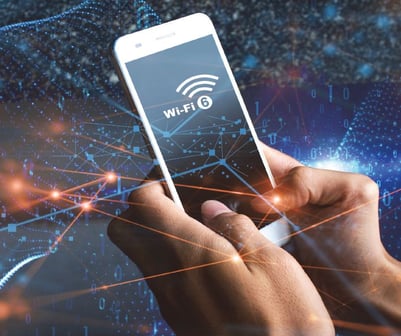Maybe you’ve heard about the new wave of wireless known as Wi-Fi 6 (802.11ax), designed to boost Wi-Fi bandwidth even higher than Wi-Fi 5! This new wave of Wi-Fi has some far-reaching implications with respect to cabling infrastructure design and media selection.
Wi-Fi 6 wireless access points (WAPs) need two class EA/category 6A or higher connections. Wi-Fi 6 WAPs (across all price points) will need at least one class EA/category 6A connection to support either 2.5 Gb/s or 5 Gb/s transmission speeds. And to take full advantage of Wi-Fi 6 technology as it matures to support greater than 5 Gb/s, two connections will be required to support link aggregation.

Wi-Fi 6 requires a minimum of 25 Gb/s capable backbone. Installing a 25 Gb/s capable multimode optical fiber backbone will be required to support Wi-Fi 6 uplink capacity. In fact, this is already a key recommendation for Wi-Fi 5 implementations per industry cabling standards.
Wi-Fi 6 WAPs will need more power and thermally stable shielded cabling systems. Because Wi-Fi 6 radio chips are doing significantly more complex signal processing, they are unable to work within the 13-watt budget of Type 1 power over Ethernet (PoE) and will require 30-watt Type 2 PoE. Since the higher power can cause heat build-up in cable bundles, Wi-Fi 6 WAPs are better supported by thermally stable shielded cabling systems and solid conductor cords qualified for mechanical reliability up to 75°C (167°F). Direct connections to Type 2 PoE WAPs can also be made using field terminated plugs such as Siemon’s Z-PLUG, which supports Category 6A shielded cabling and exceeds all Category 6A performance requirements. Click HERE to request a free Z-PLUG sample.
Sometimes an evolution in technology forces consumers to stop and question legacy views about broadly deployed operating platforms or systems. Wi-Fi 6 is that technology – easily making the wait-and-see position that many have had regarding deploying 10 Gb/s-capable horizontal networks a thing of the past.
To learn more about the cabling implications of Wi-Fi 6 and to familiarize yourself with some key design and media selection strategies to ensure that your network cabling infrastructure is ready, click HERE to download Siemon's new white paper, “Preparing for Wi-Fi 6: Cabling Considerations for High Efficiency Wireless Access Point Connections.”


.png?width=58&height=58&name=X_logo_2023_(white).png)
